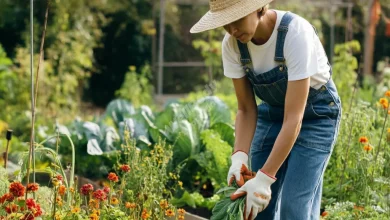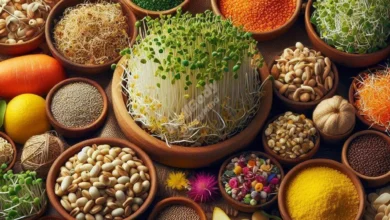Sustainable Nutrition: Boosting Wellness and the Planet

Did you know that what’s good for your body can also be good for the planet? Welcome to the world of sustainable nutrition! This exciting approach to eating isn’t just a trend – it’s a powerful way to boost your physical wellness while helping the environment.
In this post, we’ll explore how sustainable eating practices can make you feel better, stronger, and more energetic. We’ll also share simple tips to help you make eco-friendly food choices that nourish both you and the Earth.
Ready to discover how your fork can be a tool for personal and planetary health? Let’s dive in!
Understanding Sustainable Nutrition
What is Sustainable Nutrition?
Sustainable nutrition is all about eating in a way that’s good for you and the planet. It’s like giving a high-five to your body and Mother Earth at the same time!
This approach to eating focuses on foods that are:
- Grown or produced with minimal environmental impact
- Nutritious and health-promoting
- Accessible and affordable for most people
- Culturally acceptable and appealing
Key Principles of Sustainable Eating
Let’s break down the main ideas behind sustainable nutrition:
- Eat more plants: Fruits, veggies, nuts, and grains are stars in a sustainable diet.
- Choose local and seasonal: Food that doesn’t travel far is fresher and uses less fuel.
- Reduce food waste: Use what you buy and compost what you can’t eat.
- Pick sustainably sourced animal products: If you eat meat or dairy, choose options that are better for the environment.
- Avoid over-processed foods: Whole foods are usually better for you and the planet.
How is Sustainable Nutrition Different?
Sustainable nutrition isn’t just another diet fad. Here’s how it stands out:
- Focus on the big picture: It’s not just about calories or weight loss. Sustainable eating considers your health, the environment, and even social factors.
- Long-term thinking: Instead of quick fixes, sustainable nutrition promotes habits that are good for you and the planet in the long run.
- Flexibility: There’s no one-size-fits-all approach. Sustainable eating can be adapted to different cultures, preferences, and needs.
- Quality over quantity: It emphasizes the importance of nutrient-dense foods rather than just counting calories.
By following sustainable eating practices, you’re not just fueling your body – you’re contributing to a healthier world. In the next section, we’ll explore how this approach can boost your physical wellness in amazing ways.
The Impact of Sustainable Nutrition on Physical Wellness
Sustainable eating isn’t just good for the planet – it’s a powerhouse for your health too! Let’s explore how this approach can boost your physical wellness in four key areas.
Improved Nutrient Intake
Sustainable nutrition is like a nutrient goldmine for your body. Here’s why:
- Fresh and local foods are often packed with more vitamins and minerals.
- Seasonal produce is typically harvested at peak ripeness, maximizing its nutritional value.
- Sustainably grown foods often have higher levels of beneficial compounds like antioxidants.
Key nutrients you’ll often find in sustainably produced foods include:
- Vitamin C
- Vitamin A
- Folate
- Potassium
- Fiber
Enhanced Digestive Health
Your gut will thank you for choosing sustainable nutrition! Here’s how:
- Fiber-rich foods: Sustainable diets often include more whole grains, fruits, and vegetables. These fiber powerhouses keep your digestive system running smoothly.
- Less processed food: By focusing on whole foods, you’re giving your digestive system a break from hard-to-process artificial ingredients.
- Diverse plant foods: A varied diet promotes a healthy gut microbiome, which is crucial for overall digestive health.
Better Weight Management
Sustainable eating can be your ally in maintaining a healthy weight. Here’s why:
- Nutrient-dense foods help you feel fuller for longer, reducing overeating.
- Mindful eating, a common practice in sustainable nutrition, helps you tune into your body’s hunger and fullness cues.
- Whole foods are often lower in calories but higher in nutrients compared to processed alternatives.
Increased Energy Levels
Feel like you need an extra boost? Sustainable nutrition might be the answer:
- Balanced macronutrients: A sustainable diet provides a good mix of carbs, proteins, and healthy fats for steady energy.
- High-quality foods: Nutrient-rich, minimally processed foods provide clean fuel for your body.
- Reduced toxins: Sustainably produced foods often have fewer pesticides and additives that can drain your energy.
Sustainable Nutrition Practices for Optimal Physical Wellness
Now that we know the benefits, let’s explore how to put sustainable nutrition into practice!
Eating Locally and Seasonally
Benefits of local, seasonal produce:
- Fresher taste
- Higher nutrient content
- Supports local economy
- Reduces transportation emissions
Tips for eating locally:
- Visit farmers’ markets
- Join a community-supported agriculture (CSA) program
- Grow your own herbs or vegetables
- Check food labels for origin information
Reducing Meat Consumption
Cutting back on meat is a win-win for your health and the environment. Here are some plant-based protein alternatives:
| Plant-Based Protein | Protein Content (per 100g) |
|---|---|
| Lentils | 9g |
| Chickpeas | 19g |
| Tofu | 8g |
| Quinoa | 4g |
| Almonds | 21g |
Minimizing Food Waste
Reducing food waste is crucial for sustainability. Try these tips:
- Plan your meals in advance
- Store foods properly to extend their life
- Use leftovers creatively
- Compost inedible food scraps
- Understand food expiration dates
Choosing Whole Foods Over Processed Options
Whole foods are the cornerstone of sustainable nutrition. Here are some easy swaps:
- Choose brown rice instead of white rice
- Opt for whole fruit rather than fruit juice
- Pick raw nuts over salted, roasted varieties
- Select whole grain bread instead of white bread
Remember, small changes can make a big difference. In the next section, we’ll address common challenges in adopting sustainable nutrition and how to overcome them.
Overcoming Challenges in Adopting Sustainable Nutrition
While sustainable eating offers many benefits, it’s not always easy to make the switch. Let’s tackle some common hurdles and find practical solutions.
Challenge 1: Cost Concerns
Many people worry that sustainable eating is expensive. Here’s how to eat sustainably on a budget:
- Buy in bulk: Purchase non-perishable items in larger quantities to save money.
- Shop seasonally: In-season produce is often cheaper and more abundant.
- Reduce meat consumption: Plant-based proteins are usually more affordable than meat.
- Grow your own: Start a small herb garden or grow some vegetables at home.
Challenge 2: Limited Availability
Sometimes, sustainable options aren’t readily available. Try these strategies:
- Explore local markets: Farmers’ markets often offer sustainable, locally-grown produce.
- Join a CSA program: Community Supported Agriculture programs provide regular deliveries of local, seasonal produce.
- Shop online: Many sustainable food producers now offer online ordering and delivery.
- Advocate for change: Ask your local grocery store to stock more sustainable options.
Challenge 3: Time Constraints
Busy schedules can make sustainable eating challenging. Here are some time-saving tips:
- Meal prep: Dedicate a few hours each week to preparing meals in advance.
- Use a slow cooker: Throw ingredients in before work and come home to a ready meal.
- Keep it simple: Not every meal needs to be complex. Simple, whole foods can be quick and nutritious.
- Batch cook: Make large portions and freeze leftovers for future meals.
Remember, every small step counts. You don’t have to overhaul your entire diet overnight. Start with one or two changes and build from there.
The Future of Sustainable Nutrition
Exciting developments are on the horizon for sustainable nutrition. Here’s a glimpse into what the future might hold:
Emerging Trends
- Regenerative agriculture: This approach goes beyond sustainability, aiming to improve soil health and biodiversity.
- Plant-based meat alternatives: These products are becoming more realistic and nutritious.
- Vertical farming: Growing food in vertically stacked layers could revolutionize urban agriculture.
- Personalized nutrition: Tailoring diets based on individual genetics and microbiomes may become more common.
Technological Advancements
Technology is playing a crucial role in advancing sustainable nutrition:
- AI and machine learning: These tools are helping optimize crop yields and reduce food waste.
- Blockchain: This technology can improve food traceability, ensuring more transparent and sustainable supply chains.
- 3D food printing: This could reduce food waste and create personalized nutrition solutions.
- Gene editing: CRISPR technology may help develop more resilient and nutritious crops.
As these innovations progress, sustainable nutrition will likely become more accessible, affordable, and effective in promoting both personal and planetary health.
Conclusion
We’ve journeyed through the world of sustainable nutrition and discovered its powerful impact on physical wellness. From boosting nutrient intake to enhancing digestive health, managing weight, and increasing energy levels, sustainable eating practices offer a holistic approach to nourishing our bodies.
Remember, sustainable nutrition isn’t just a diet—it’s a lifestyle that benefits both you and the planet. By making mindful choices like eating locally and seasonally, reducing meat consumption, minimizing food waste, and choosing whole foods, you’re taking steps towards a healthier you and a healthier Earth.
Don’t be discouraged by challenges—start small and celebrate each sustainable choice you make. Whether it’s trying a new plant-based recipe or shopping at your local farmers’ market, every action counts.
As we look to the future, exciting developments in sustainable nutrition promise to make this approach even more accessible and effective. By embracing sustainable eating now, you’re not just nourishing your body—you’re nourishing the future.
Are you ready to take the next step in your sustainable nutrition journey? Why not start today with one small change? Your body—and the planet—will thank you!



